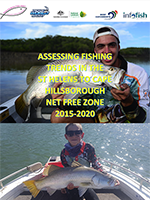Data Captures Improved Catch from Net Free Zone
Increased catch rates, more legal fish, larger fish and more trophy sized fish.
It sounds a recreational fishers dream, and data from the Mackay Recreational Fishers Alliance Inc (MRFA) has shown it to be the case after six years of data gathered in the St Helens to Cape Hillsborough Net Free Zone (NFZ).

Photo: Marty Strecker Photography
The Infofish Australia report Assessing Fishing Trends in the St Helens to Cape Hillsborough Net Free Zone 2015-2020 was prepared for MRFA and represents up to 9,000 hours of fishing information collected from participating fishers (approximately 1,500 hours per survey).
An initial survey was conducted in October 2015, prior to the declaration of a NFZ, with further surveys conducted from February-April each year from 2016-2020.
As well as improved catch across the board, the report indicated an exciting comeback of King and Blue Threadfin. These species were reported at very low numbers as ‘incidental catch’ in 2015, to be key targets and comprising 7.5% and 7.4% of the catch in 2019. In addition, King Threadfin went from ‘none caught’ in 2015 to being 15.8% trophy fish over 1m in 2019.
Barramundi continued to increase as the prime target and most caught species, comprising 45% of the overall catch in 2020. In 2020, 84.5% of Barramundi caught were legal size (over 580mm) and 42.8% were kept.
Whiting and Golden Snapper were the most kept species.
Importantly the report also highlighted changing attitudes from fishers when it comes to releasing fish, even those at a legal size. The proportion of legal fish released over the 5-year period increased significantly and was not related to the possession limit – in 2020, the report found 52.5% of all legal fish were released.
Boat ramp surveys were undertaken at key boat ramps within the NFZ (including Victor Creek, Murray Creek and St Helens Creek) and online forms were also provided to fishers.
About the Mackay Recreational Fishers Alliance Inc
MRFA is a not-for-profit organisation who are serious about sustainable fishing now and for the future. The group were the principal proponent in the establishment of the St Helens to Cape Hillsborough NFZ and play a valuable role in data collection. Their input was integral to the creation of this important community-led assessment and report, with the aim of quantifying changes in the local NFZ.
Initial funding for this project was provided by Reef Catchments, through funding from the Australian Government’s National Landcare Programme.
Net Free Zones are closed to all commercial netting and were introduced by the Queensland Government in November 2015 to increase recreational fishing opportunities, supporting tourism and economic growth in regional areas.



